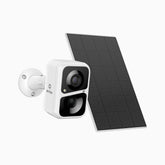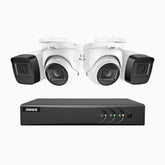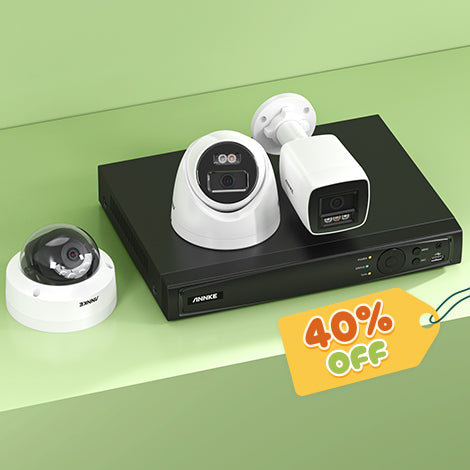Super Ultra Wide Angle Security Cameras: Can't Miss Buying Guide
In traditional security systems, most security cameras had a horizontal field of view of only about 70°–90°. That might work for a small room, but the moment you try to cover an entire driveway, garden, parking lot, or office floor, blind spots appear. With limited coverage per camera, you’re forced to spend more money and time just to watch the whole space.

In the past, people solved this by buying multiple cameras or even multi-camera kits. The budget 4 camera-systems might cost around 200 EUR, but high-end systems can easily go over 1,000 EUR. More cameras also mean more wiring, more network ports, more maintenance, and more complicated management.
In recent years, advances in lenses, sensors, and image algorithms have made it possible for a single camera to deliver a wide or even panoramic field of view. Instead of relying on two or more narrow-angle cameras, one wide-angle or multi-lens device can now cover areas like driveways, gardens, offices, or warehouse aisles, showing the full scene without switching between multiple screens. This is why wide-angle cameras are gaining popularity.
In this guide, we’ll show you some of the best wide-angle security cameras available today and explain what to look for before you buy. By the end, you’ll know how to choose a camera that fits your space, your budget, and your security needs — and how to get the most out of it once it’s installed.
Why Wide-Angle Cameras Are Important
Cover More with Fewer Cameras
You can use one wide-angle camera to monitor spaces that used to need several cameras. That means fewer cables to run, fewer power sources, and fewer devices to maintain — saving you time and money while simplifying your system.
Reduce Blind Spots and Gain Context
A broader view lets you understand the relationships between people, vehicles, and spaces. This context makes it easier to respond quickly and appropriately.
Capture More Details Across the Frame
Unlike standard lenses that narrow your view, ANNKE’s wide-angle lenses are designed to keep sharpness and color even at the edges, so you don’t miss important information where it matters.
Flexible Placement
Because you see more, you can mount cameras in corners or at the edge of a property and still cover the whole area. This gives you more freedom to install your camera where it’s safest or easiest.
How Security Cameras’ Angle Define
When people talk about a camera’s “angle,” they’re really talking about its field of view (FOV). Two things decide how wide that view is:
Lens focal length: Shorter focal length = wider view.
Sensor size: Bigger sensors capture more of the scene at the same focal length.
In security cameras, lens focal length directly controls the field of view:
2.8 mm lens → about 110° ultra-wide
4 mm lens → about 80° wide-angle
6 mm lens → about 55° medium view
12 mm lens → about 25° narrow view
The shorter the focal length, the wider the angle you see. Wide-angle lenses (typically over 90°) let you view a larger area, while longer lenses zoom in for more detail but cover less ground.
This is why a camera with the right lens–sensor combo feels like it “opens up” the space in front of it.
How “Wide” Is Wide in a Security Camera
In the security world, there’s no single standard for what counts as “wide-angle.” Many traditional cameras stay around 70°–90° horizontal FOV, which often leaves blind spots in larger spaces. At ANNKE, we define 100°+ horizontal FOV as truly wide-angle, because once you pass that threshold, one camera can cover most areas that would otherwise require multiple units. Our widest models reach 180° panoramic or even 360° fisheye-style coverage, letting you see entire scenes at once with fewer cameras.
Wide Angle Security Cameras Buying Guide
1. FOV & Focal length
Look for 100°+ horizontal FOV to get a true wide view. Some brands advertise “100°” but they’re quoting the diagonal field of view, not the horizontal FOV you actually see across your screen — always check the spec sheet to see what’s real. Shorter focal length = wider view, but more width doesn’t always mean more detail. For full coverage, consider 150°–180° panoramic or 360° fisheye/multi-lens models, but balance width with clarity.
2. Resolution
A camera’s sensor holds a fixed number of pixels — a 4MP camera always has 4 million pixels, no matter how wide the lens is.
With a very wide lens, those pixels spread across a larger scene, that means fewer pixels per square foot of your image and less detail for each object. A 4MP camera at 180° won’t show as much detail per object as one at 60°.
Pixels alone don’t guarantee sharpness — field of view, lens quality, and lighting all matter. But at the same angle, higher resolution still captures finer detail (e.g., 8 MP at 180° shows more than 4 MP). For general monitoring, 2K–4MP works well; for plates, faces, or distant critical areas, go 4K+ with a solid lens and good low-light performance.
3. Sensor size & aperture (low-light)
Look for larger sensors (1/2.8″ or bigger) and larger apertures (f/1.0–f/1.6) because they collect more light, giving you cleaner images at night. A wide-angle camera with a small sensor may struggle in low light.
4. Night vision type
IR/EXIR gives discreet black-and-white images, while white light or hybrid lighting can show true color but may be more visible to intruders. For most homes and businesses, hybrid smart lighting works best: stealth IR for normal monitoring, color lighting for deterrence or events. Also check effective range (20 m vs 30 m) — more isn’t always better if it causes glare up close.
5. Combine with AI Features
Use AI smart detection to identify people, vehicles, and activities across the entire wide frame.
6. Fixed vs varifocal vs multi-lens
Fixed wide lenses (2.8 mm) are simple and cost-effective. Varifocal or motorized lenses let you zoom or adjust after installation. Multi-lens or dual-lens models stitch multiple views into one ultra-wide frame with less distortion. Think about whether you need flexibility or just a straightforward wide view before buying.
7. Weatherproofing & materials
For outdoor use, pick IP66/IP67 or higher. If you’re near salt air or heavy humidity, look for corrosion-resistant housing or anti-salt coatings. A wide-angle camera covers more area, so losing it to weather failure leaves a big blind spot — invest in durability as well as specs.
Quick rule of thumb: if your goal is wide situational awareness (parking lot, lobby), prioritize FOV, sensor size, and robust night handling. If you need forensic detail (plates, faces), prioritize resolution, lens choice, and placement.
How ANNKE Stacks Up: Comparisons & Why It Matters
Compared to ordinary wide-angle or stitched-lens cameras, ANNKE’s wide-angle series stands out in several ways:
Seamless View: Some cameras show lines or color mismatches where images are stitched. ANNKE’s calibration algorithms and alignment tech minimize cracks and stitching artifacts.
Sharp Edges: Standard lenses often lose clarity at the edges. ANNKE wide-angle cameras maintain sharpness and color consistency across the frame.
Comprehensive Features: While many cameras offer only basic human/vehicle detection, ANNKE expands to area intrusion, loitering detection, and more, for richer insights.
Built to Last: Outdoor cameras face rain, humidity, and temperature swings. ANNKE uses durable, corrosion-resistant materials and high IP ratings for longer life in harsh conditions.
Best Wide Angle Security Cameras: Top 4 Picks
With so many wide-angle security cameras on the market, choosing the right one for your space can be overwhelming. But don't worry—ANNKE makes it easy. We offer a variety of wide-angle cameras with varying focal lengths and coverage areas, allowing you to choose the exact camera that's right for your home or business. Each model combines a wide field of view, crisp details, reliable build quality, and smart features.
FCD600 - 6MP Dual-Lens Outdoor 180° Panoramic Security Camera
FCD800 - 8MP Dual-Lens Outdoor 180° Panoramic Security Camera
NCT425 - 4MP Bullet & PTZ Dual Channel 360° Security IP Camera
How to Maximize Your Wide-Angle Camera
Here are 10 tips to help you maximize coverage and clarity with your wide-angle camera:
1. Choose the Right Mounting Height – Mount higher to see further and cover more ground.
2. Angle the Camera Carefully – A small downward angle reduces sky and ceiling in the frame, improves ground detail, and avoids excessive backlight.
3. Mind Obstacles – Keep trees, poles, or signage out of the camera’s line of sight.
4. Use Corners to Your Advantage – Placing the camera in a corner maximizes the width of coverage.
5. Check Lighting Conditions – Don’t aim the camera at bright lights, reflective surfaces, or windows. Backlight creates silhouettes; position the camera so light sources are behind or to the side.
6. Match lens to distance & detail needs – If you need both breadth and occasional detail, consider: wide fixed for overview + a second narrow/tele camera for doors/lanes (or a varifocal/dual-lens model).
7. Use software dewarping & calibration if Available – After install, run the camera’s calibration/ dewarp tools so edges are corrected and stitching artifacts minimized.
8. Use Multiple Angles for Critical Points – For entrances or exits, combine one wide-angle camera with a closer view camera for details.
9. Test and Adjust – After installation, review footage at different times of day and tweak the angle or height as needed.
10. Keep optics clean & firmware current – Wipe lenses periodically (wide lenses show artifacts more noticeably). Update firmware to get improved image processing and distortion corrections.
Why Placement Still Matters
Even the widest-angle lens can underperform if it’s mounted too low or blocked by objects. Mounting at a higher vantage point, angling slightly down, and avoiding obstructions will help you capture as much area as possible.
Wide-Angle Camera Innovation
Whether you're a homeowner or operator of a large facility, wide-angle cameras allow you to cover a wider area with less equipment and reduce blind spots. If you're considering purchasing a wide-angle camera, now is the perfect time. Please read the above carefully to make the right choice.
















